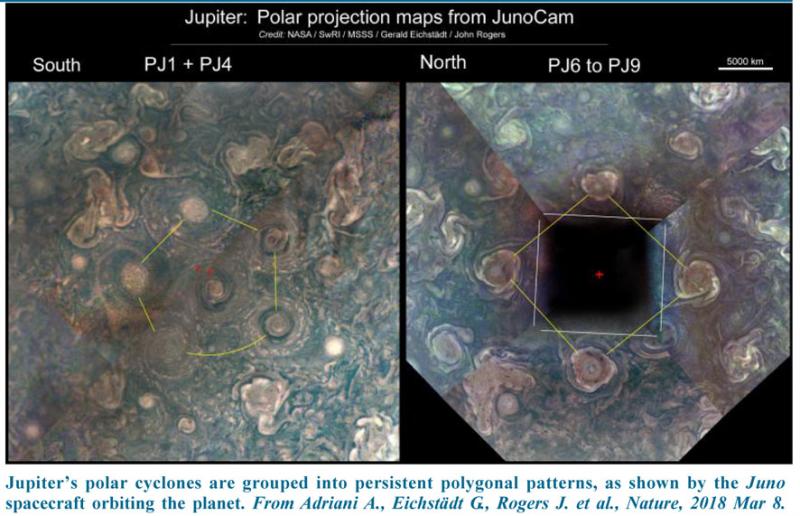Patterns of polygons in Jupiter’s polar storms
2018 March 22
 The Juno spacecraft orbiting Jupiter has discovered that cyclones around the planet’s poles are tightly packed into remarkable polygonal patterns. At the south pole, five cyclones form a pentagon around a central storm; at the north pole, eight cyclones form a modified octagon or ‘double square’ around a central one. These patterns, discovered by the JunoCam and JIRAM instruments on Juno, are described in a paper published in Nature on March 8.[1] More details and animations from the JunoCam observations can be seen in a report posted on the Jupiter Section web pages: https://britastro.org/node/12654, and animations at https://britastro.org/node/12655.
The Juno spacecraft orbiting Jupiter has discovered that cyclones around the planet’s poles are tightly packed into remarkable polygonal patterns. At the south pole, five cyclones form a pentagon around a central storm; at the north pole, eight cyclones form a modified octagon or ‘double square’ around a central one. These patterns, discovered by the JunoCam and JIRAM instruments on Juno, are described in a paper published in Nature on March 8.[1] More details and animations from the JunoCam observations can be seen in a report posted on the Jupiter Section web pages: https://britastro.org/node/12654, and animations at https://britastro.org/node/12655.
The spacecraft’s camera, JunoCam, has been viewing the circumpolar cyclones (CPCs) since the first close orbital passage (perijove), but as it can only view the side that is illuminated as it flies over each pole, the polygonal patterns only became clear over the first few perijoves. In contrast, JIRAM (the Jovian Infrared Auroral Mapper) views not reflected sunlight, but thermal infrared emission, so it recorded the entire polar regions at perijove-4, and large parts at perijove-5. Together, the two instruments have produced complete views of the polar polygons and their circulations.
The north polar CPCs have diameters of 5200–7000km, and the eight contiguous ones in the octagon are separated from the central cyclone by a narrow chaotic zone with westward flow and some vortices. The central cyclone, which can only be viewed by JIRAM as it is currently in darkness, is centred only ~0.5° latitude off the true pole. The octagon of CPCs around it has not changed substantially in over a year, with only limited swings to and fro around the pole.
The south polar CPCs have diameters ranging from ~6400–8200km, and the five forming the pentagon are mostly in contact with each other and with the central one. But the pentagon is not entirely symmetrical. It is approximately centred on the central cyclone, whose centre is offset from the pole by 1.0° to 2.5° latitude, and the JunoCam images show that this offset has varied cyclically. On the side furthest from the pole, there is a gap between two cyclones in the pentagon, and this gap grew larger over the first eight perijoves; it has now shrunk again.
The wind speeds within the CPCs, measured independently from JunoCam and JIRAM images, are mostly about 200–350km/hr at a radius of 1500km. Closer to the centres, JunoCam measurements show that some of them have even faster speeds, exceeding 450km/hr near the centre of the south polar cyclone. So these cyclones are similar to terrestrial hurricanes in wind speeds, or even faster, and they are several times larger.
These patterns are different in nature from the famous north polar hexagon on Saturn, which is a kinked jet-stream surrounding a single giant cyclone. In contrast, each pole on Jupiter has a polygonal cluster of cyclones, which are remarkably stable. They have persisted with little change over the first eleven perijoves, despite the furious winds which blow within them, and the buffetting from the chaotic, rapidly changing storm systems around them. It is not yet clear theoretically how these polygons can be stable, but they seem to be real-world examples of patterns called ‘vortex crystals’, which were previously known only from laboratory modelling.
John H. Rogers, Director, Jupiter Section
[1] Adriani A., Mura A., Orton G., Hansen C., Altieri F., Moriconi M. L., Rogers J., Eichstädt G. et al., ‘Clusters of cyclones encircling Jupiter’s poles’, Nature 555, 216-219 (2018 Mar 8)
| The British Astronomical Association supports amateur astronomers around the UK and the rest of the world. Find out more about the BAA or join us. |
